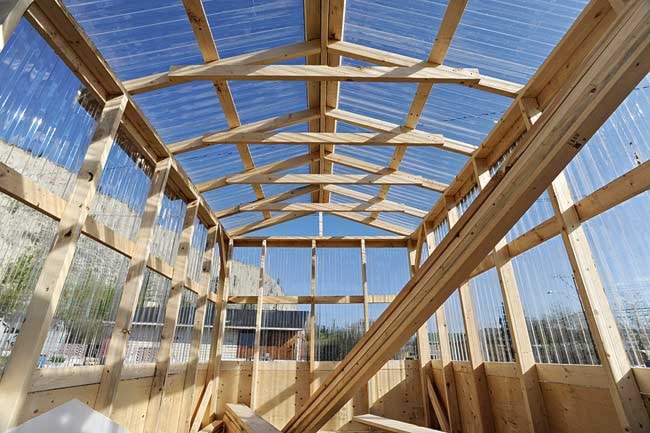DAWSON CITY
Maureen Moore was the first, female journeyman carpenter in the Yukon.
She was the only woman in the territory’s apprenticeship program at that time.
She has been working as a carpenter for 30 years.
Now, the program has more women enrolled than men, she said.
“It’s really changed since I went to school,” said Moore, standing inside the door of the Dawson’s Women’s Shelter, escaping an unexpected downpour.
She, and a few straggling participants, were putting the finishing touches on their day’s work when the rain hit.
In total, 11 women are building a greenhouse in the shelter’s side yard, on the corner of Front and Dugas streets.
The participants range in age from their mid-20s to their early-60s. Some are staff at the shelter, some are women who use the shelter and others are just women from the community who wanted to help out.
But all of them will walk away from the weekend having learned something, said Patricia Curtiss, program co-ordinator for Yukon Women in Trades and Technology, which organized the project.
“It’s really, really, unbelievably empowering,” said Curtiss about women learning a trade. “It gives them skills that they can take to other jobs. Ultimately we want this to be the spark for people to become carpenters.”
For most women, it’s the shy hesitation that’s the hardest part to get over when working with tools, said Moore.
“Some of them have fears around tools, the noise,” said Moore. “But they got over it real quick. It’s just an unknown to them. Some of them have never even handled a drill.
“And it’s language too. It’s sort of like teaching a new lingo”
“And it’s fun to see the improvement,” said Moore’s assistant Chris Withers.
“Oh my goodness ya,” Moore chimes. “They’re running around, ‘Give me that Robertson bit,’‘Let me change that driver,’ in no time.”
“In such short time, they’ve learned a lot,” said Withers.
Moore teaches a lot of workshops like this.
“It’s wonderful to see them gain the confidence to work with the tools and be comfortable with them,” she said. “It’s awesome.”
However, the greenhouse participants built in Dawson is not just for the women’s shelter. It will also help grow food for the community’s food bank, which is housed in the same building in the south end of town.
The shelter’s executive director proposed the project to Yukon Women in Trades and Technology more than six months ago.
The community really supported the idea and, once the women started building, even more people wanted to offer some help, said Curtiss.
A worker at the city dump found them a door and Gammie Trucking supplied all the gravel for free.
With that kind of community backing, it would have been a hard project to turn down, said Curtiss.
“Plus we are mandated to do work in the communities,” she said. “And we hadn’t been to Dawson yet for any of our programming. We needed to get up here and help the ladies learn some trades and trade skills.”
Earlier in the week, another greenhouse was built through Yukon Women in Trades and Technology, except female inmates at the Whitehorse Correctional Centre built that one.
It is the second greenhouse the inmates have built. Last year they built one for their yard at the annex. This year, the greenhouse they built was lifted out of the facility’s yard moved to the Downtown Urban Gardeners Society community garden near Whitehorse’s clay cliffs. Both industrial businessman Wayne Schmidt and RC Crane helped out pro-bono, said Curtiss.
Back in the rain in Dawson City, work has stopped for the day.
The roof’s rafters have been put up, the skeleton of the frame is assembled and paint is already covering the exterior baseboards.
“When I started with WITT I really wanted to create projects that were usable after,” said Curtiss, looking at the women cleaning up supplies and covering them with tarps. “We want to be more sustainable with our projects.
“So this is very similar to framing a house, all the skills are the same.
“But knowing that the women that stay here, and the food bank, are going to be utilizing the vegetables that are grown in there, it’s just a really great partnership.”
Contact Roxanne Stasyszyn at
roxannes@yukon-news.com
